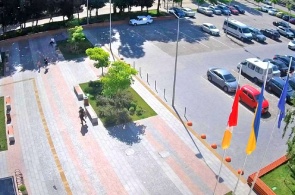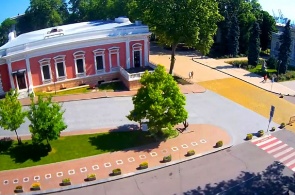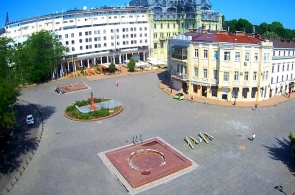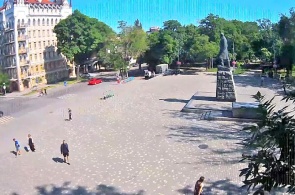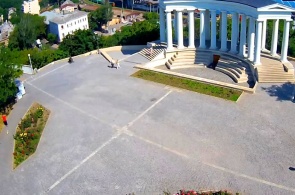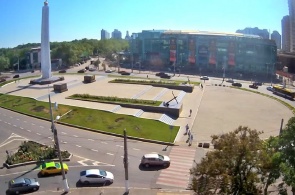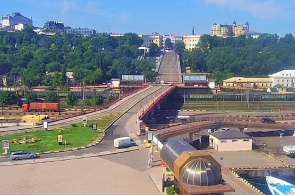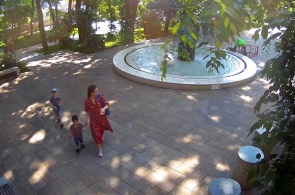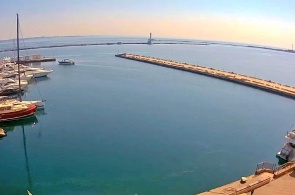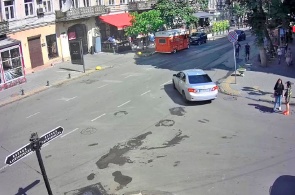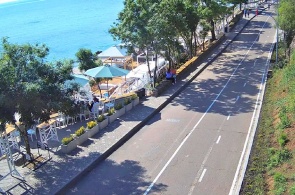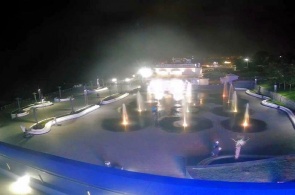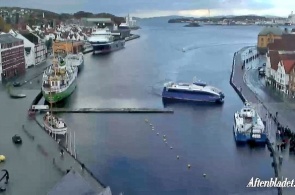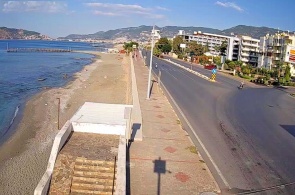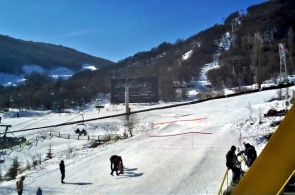Live webcam opens a view of the Potemkin Stairs in Odessa. Potemkin Stairs is a boulevard "cascade" of Odessa, which has gained fame as a symbol of the city. It owes its modern name to the historical drama Battleship Potemkin, a film by Sergei Eisenstein, released in 1925.
Previously, the Potemkin Stairs were referred to as Richelievskaya, Bolshaya, Portovaya, Primorskaya and Boulevard, depicted on old postcards of the 19th-20th centuries. From the upper steps of the architectural monument, an amazing panorama of the country's large commercial port, harbor and Odessa bay opens.
History of the Potemkin Stairs
Since its founding, Odessa has needed unhindered access to the Black Sea. At that time, the city was located on a hill close to the coastline, ending in a steep descent, which was fenced with a railing for the safety of passers-by. The famous Russian poet A.S. Pushkin walked along the path to the sea, risking slipping down at any moment. He did not manage to wait for the appearance of wooden stairs, which greatly facilitated the walk to the sea: they appeared some time after the poet's departure from Odessa. Now everyone could go down to the coast to walk in the morning fog and admire the serene smoothness of the sea water.
The construction of the staircase began on the initiative of Count M.S.Vorontsov. According to one of the versions, this descent was intended as a gift to Countess Elizabeth, who loved the daily promenades and the rolling sound of the waves. Other theories concern the "ennobling" of the city before the visit of Emperor Nicholas I and the activities of the Freemasons.
Potemkin Stairs is an architectural project of 1835, designed by Franz Boffo, Charles (Karl) Potier and Abraham Melnikov. The construction of the city's business card was completed by 1841 thanks to the well-coordinated work of engineers Morozov and Upton. Classicism, characteristic of that era, was reflected in the rhythmic cascade of the Potemkin Stairs.
Funds for the construction of the main descent to the Black Sea were allocated from the treasury, which was replenished through economic activities, customs duties and deductions. The construction of the Potemkin Stairs cost 200 thousand rubles - a record amount at that time. The appearance of the grand staircase descent has become an international event, which has been repeatedly mentioned in articles in the English and American periodicals.
The beginning of the 20th century was marked by the opening of the funicular along the stairs. In the 1970s, it was replaced by an escalator, which ceased to function after 20 years. By the 211st founding of Odessa, the city authorities pleased the local residents with the decision to build a new funicular. Since 2005, two carriages with a total capacity of 24 people have been moving along the Potemkin Stairs. The whole journey takes just over a minute.
Previously, the Potemkin Stairs were referred to as Richelievskaya, Bolshaya, Portovaya, Primorskaya and Boulevard, depicted on old postcards of the 19th-20th centuries. From the upper steps of the architectural monument, an amazing panorama of the country's large commercial port, harbor and Odessa bay opens.
History of the Potemkin Stairs
Since its founding, Odessa has needed unhindered access to the Black Sea. At that time, the city was located on a hill close to the coastline, ending in a steep descent, which was fenced with a railing for the safety of passers-by. The famous Russian poet A.S. Pushkin walked along the path to the sea, risking slipping down at any moment. He did not manage to wait for the appearance of wooden stairs, which greatly facilitated the walk to the sea: they appeared some time after the poet's departure from Odessa. Now everyone could go down to the coast to walk in the morning fog and admire the serene smoothness of the sea water.
The construction of the staircase began on the initiative of Count M.S.Vorontsov. According to one of the versions, this descent was intended as a gift to Countess Elizabeth, who loved the daily promenades and the rolling sound of the waves. Other theories concern the "ennobling" of the city before the visit of Emperor Nicholas I and the activities of the Freemasons.
Potemkin Stairs is an architectural project of 1835, designed by Franz Boffo, Charles (Karl) Potier and Abraham Melnikov. The construction of the city's business card was completed by 1841 thanks to the well-coordinated work of engineers Morozov and Upton. Classicism, characteristic of that era, was reflected in the rhythmic cascade of the Potemkin Stairs.
Funds for the construction of the main descent to the Black Sea were allocated from the treasury, which was replenished through economic activities, customs duties and deductions. The construction of the Potemkin Stairs cost 200 thousand rubles - a record amount at that time. The appearance of the grand staircase descent has become an international event, which has been repeatedly mentioned in articles in the English and American periodicals.
The beginning of the 20th century was marked by the opening of the funicular along the stairs. In the 1970s, it was replaced by an escalator, which ceased to function after 20 years. By the 211st founding of Odessa, the city authorities pleased the local residents with the decision to build a new funicular. Since 2005, two carriages with a total capacity of 24 people have been moving along the Potemkin Stairs. The whole journey takes just over a minute.
More details
Live webcam broadcasts a view of the parking lot of the Center for Integrated Social Services in Odessa. Odessa was among the first cities to be attacked by the fascist invaders. Already in August 1941, the city was completely surrounded by land, there was only sea communication through the Black Sea Fleet. From the sea side, Odessa received not only food, but also powerful fire defense.
Odessa, Ukraine
18.06.21
Live webcam broadcasts live from the Alley of Stars in Odessa. For the City Day in 2014, the Avenue of Stars was opened on Lanzheronovskaya Street. The first stars are dedicated to Odessa itself, as well as to famous Odessa citizens: Isaac Babel, Yuri Olesha, Anna Akhmatova and Kira Muratova.
Odessa, Ukraine
18.06.21
Live webcam broadcasts a view of the Greek Square in Odessa. Not so long ago, Greek Square was called quite differently - Martynovsky Square. But, despite the name change, it has not become less attractive for tourists and guests of Odessa. It is very easy to find it, since the square is located in the city center and is located between the famous Deribasovskaya street and Bunin street.
Odessa, Ukraine
17.06.21
The online webcam opens a view of the monument to Taras Grigorievich Shevchenko in Odessa. The monument was erected in 1966. The marble sculpture on a granite pedestal was created by sculptors A. Belostotsky and O. Suprun and architect G. Topuz. The height of the monument is 9 meters, around it there is a granite parapet.
Odessa, Ukraine
17.06.21
Live webcam shows a view of the Colonnade of the Vorontsov Palace in Odessa. The Vorontsov Colonnade was built in 1834 by the famous Italian architect Franz Boffo by order of the Governor-General of the city Mikhail Semyonovich Vorontsov.
Odessa, Ukraine
16.06.21
The camera broadcasts a live broadcast from the 10th April Square in Odessa. 10 April Square was formed in the mid-80s as a new urban interchange. The result of the construction was the emergence of a new street - Genoese. They decided to name it in honor of the sister city of Odessa, with which they became related back in 1972.
Odessa, Ukraine
16.06.21
Live webcam broadcasts live on the Potemkin Stairs in Odessa. Potemkin Stairs - a boulevard descent in Odessa, leading to the sea. The staircase is one of the most recognizable symbols of the "pearl by the sea", it is often called the "eighth wonder of the world". The Potemkin Staircase is made in the style of classicism; it is not just a pleasant place for walking, but also a real monument of architecture of the nineteenth century.
Odessa, Ukraine
15.06.21
Live webcam broadcasts a view of the intersection of Marazlievskaya - Uspenskaya streets in Odessa. The capital of humor, the heroic city of Odessa is located in the picturesque southern part of Ukraine. It is a major regional center, a key base for the Naval Forces. It is a large Black Sea port city with a large turnover.
Odessa, Ukraine
15.06.21
Live webcam shows a view of the Greek Park in Odessa. A cozy park, lurking near Primorsky Boulevard, has recently officially become the Greek Park, and was previously known under the romantic name Lunny Square. Once it was one of the most well-groomed, with scented beds of bright colors and always-on lighting in the dark.
Odessa, Ukraine
14.06.21
Live webcam broadcasts a live broadcast from the Odessa Yacht Club. From the webcam perspective, we can observe the famous Vorontsov lighthouse - one of the main symbols of Odessa, the lighthouse was established on the initiative of the famous Russian naval commander, discoverer of Antarctica, Admiral Mikhail Petrovich Lazarev.
Odessa, Ukraine
14.06.21
The live camera opens a view of Yekaterininskaya Street in Odessa. The street Ekaterininskaya itself appeared among the first on the city plan. The street is named, according to some sources, in honor of Empress Catherine II, who commanded the city and port to be, according to others, it got its name from the Church of St. Catherine, founded but never built on Catherine Square.
Odessa, Ukraine
14.06.21
The live camera broadcasts a live broadcast from the famous Deribasovskaya Street - the real heart of Odessa, it is here that the heroes of famous anecdotes and songs walk, and locals love to come here during the holidays - City Day, Odessa Humorina. Deribasovskaya is often mentioned in folk stories and sensational films.
Odessa, Ukraine
13.06.21
The live camera broadcasts a view of the health track in Odessa, which stretches from Shevchenko Park and Lanzheron Beach along a picturesque slope and sandy beaches to Arcadia itself. The name of the route alone speaks of its purpose: here in winter and summer cyclists, roller skaters, sports joggers and hikers rush in endless rows.
Odessa, Ukraine
13.06.21
Overview webcam online with a view of the embankment with fountain square in NEMO Hotel Resort & SPA Odessa. NEMO Hotel Resort & SPA-an exclusive five-star hotel on the beach! Its unique location and the highest level of service make it truly the best hotel in Odessa.
Odessa, Ukraine
31.05.21
popular camerasshow all
Sultanahmet or Blue mosque is a work of art of Turkish-Islamic architecture. Its construction began in 1609, the construction work took seven years to a 19-year-old Sultan. The name of the mosque was, due to its interesting and unique finish.
Istanbul, Turkey
Stavanger, a town in the commune of Norway, located in the South-Western part of the country, on the Peninsula, rich in minerals. Tanager combines the influence of foreign organisations such as NATO and oil companies. The camera will shoot the harbour and the promenade of the city.
Stavanger, Norway
A webcam broadcasts the district of Tosmur - quiet location in the Eastern part of Alanya, located only five kilometres from the city centre. Its rural way of life and the beauty of untouched nature attract tourists.
Alanya, Turkey
Shark Island or in English of Shark island, located in the harbour city of Sydney, the suburb of Point Piper. The locals, the natives named the island Boambilly, which translated means Shark island. After all, this name is not casual, because it's mean and looks like a shark fin.
Sydney, Australia
The webcam is installed on site Alva. Tsaghkadzor ski resort town in Armenia. Tsaghkadzor is a beautiful mountainous area among deciduous forests, with a pleasant winter climate, and clean fresh air. The highest point is 1800 meters. The truss type is a classic, divided into three.
Tsakhkadzor, Armenia

